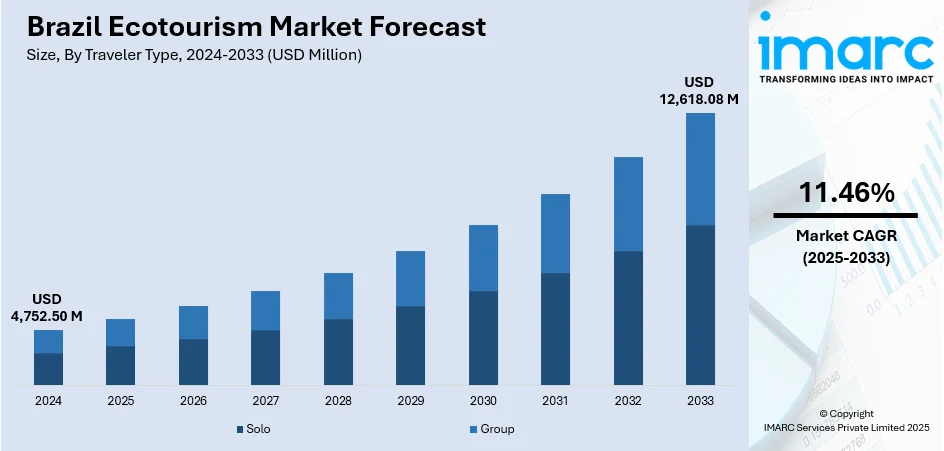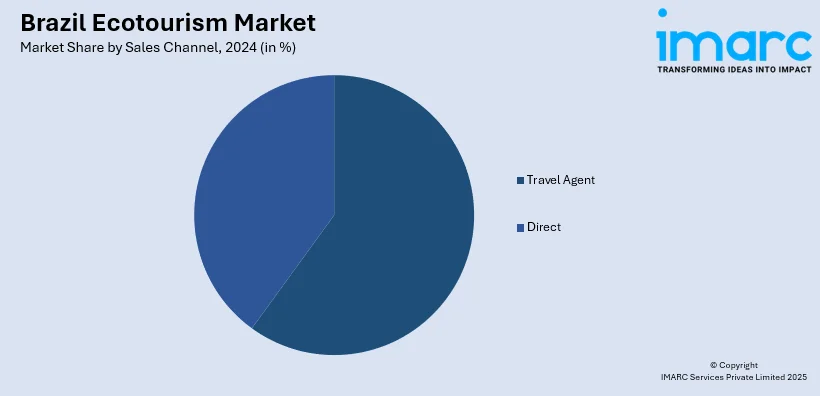
Brazil Ecotourism Market Size, Share, Trends and Forecast by Traveler Type, Age Group, Sales Channel, and Region, 2025-2033
Brazil Ecotourism Market Overview:
The Brazil ecotourism market size reached USD 4,752.50 Million in 2024. The market is projected to reach USD 12,618.08 Million by 2033, exhibiting a growth rate (CAGR) of 11.46% during 2025-2033. The market is fueled by the nation's unmatched biodiversity and natural points of interest which are strongly appealing to eco-aware tourists. Additionally, government strategies for sustainable tourism, such as community-based tourism initiatives and eco-certifications, are supporting environmentally friendly tourism practices. Also, increased global demand for nature-focused experiences is stimulating investments in ecotourism infrastructure and conservation-led hospitality, thus augmenting the Brazil ecotourism market share.
|
Report Attribute
|
Key Statistics
|
|---|---|
|
Base Year
|
2024
|
|
Forecast Years
|
2025-2033
|
|
Historical Years
|
2019-2024
|
| Market Size in 2024 | USD 4,752.50 Million |
| Market Forecast in 2033 | USD 12,618.08 Million |
| Market Growth Rate 2025-2033 | 11.46% |
Brazil Ecotourism Market Trends:
Strategic Repositioning of Ecotourism within National Tourism Policy
A prominent trend in the market is the strategic repositioning of nature-based tourism within national development and tourism promotion frameworks. Policymakers are increasingly recognizing ecotourism as a tool for balancing economic growth with environmental preservation, especially in underexplored biomes like the Amazon, Cerrado, and Pantanal. Efforts are underway to shift the tourism narrative away from traditional beach-centric travel toward experiences rooted in biodiversity, sustainability, and cultural heritage. For instance, in 2024, Brazil aims to rebrand itself as a premier destination for environmental tourism by hosting the COP30 climate summit in Belém, deep in the Amazon rainforest, with a focus on sustainability and deforestation reduction. With only 9 % of visitors participating in ecotourism versus two‑thirds who seek beach holidays, authorities intend to attract environmental and adventure travelers through expanded flight routes and increased cruise port access. This repositioning involves integrating ecotourism objectives into broader tourism strategies, enhancing regional connectivity, and improving access to remote ecological sites through transport and hospitality infrastructure upgrades. Emphasis is also being placed on training local communities, guides, and businesses in sustainability practices to ensure consistency with conservation goals. Marketing campaigns now highlight Brazil's ecological richness and unique ecosystems to attract a global demographic seeking meaningful, low-impact travel. This strategic shift not only diversifies the country's tourism economy but also strengthens its global positioning as a responsible and sustainable travel destination.

To get more information on this market, Request Sample
Integration of Technology in Ecotourism Experiences
The integration of digital technologies is significantly accelerating the Brazil ecotourism market growth, aligning with the country's rising digital connectivity. As of early 2025, Brazil had 183 million internet users, with an online penetration rate of 86.2%, creating a robust foundation for digital engagement in tourism experiences. This widespread internet access is enabling the adoption of innovative tools that enhance visitor interaction while preserving fragile ecosystems. Mobile apps, GPS-enabled guides, and virtual reality previews are now commonly used to offer immersive, educational experiences without disrupting natural habitats. In ecologically sensitive regions like the Amazon, tech-driven interpretive tools provide insights into biodiversity and indigenous knowledge, allowing for responsible exploration. Eco-conscious booking platforms have also evolved, allowing users to filter accommodations and activities based on sustainability criteria such as environmental certifications, carbon offset programs, and community participation. Furthermore, operators are utilizing digital technologies for ecological monitoring and crowd management, employing drones and geofencing to ensure minimal human impact. As digital infrastructure continues to reach Brazil's remote areas, technology is expected to play an increasingly central role in shaping informed, low-impact, and traceable ecotourism experiences.
Brazil Ecotourism Market Segmentation:
IMARC Group provides an analysis of the key trends in each segment of the market, along with forecasts at the country and regional levels for 2025-2033. Our report has categorized the market based on traveler type, age group, and sales channel.
Traveler Type Insights:
- Solo
- Group
The report has provided a detailed breakup and analysis of the market based on the traveler type. This includes solo and group.
Age Group Insights:
- Generation X
- Generation Y
- Generation Z
A detailed breakup and analysis of the market based on the age group have also been provided in the report. This includes generation X, generation Y, and generation Z.
Sales Channel Insights:

- Travel Agent
- Direct
The report has provided a detailed breakup and analysis of the market based on the sales channel. This includes travel agent and direct.
Regional Insights:
- Southeast
- South
- Northeast
- North
- Central-West
The report has also provided a comprehensive analysis of all the major regional markets, which include Southeast, South, Northeast, North, and Central-West.
Competitive Landscape:
The market research report has also provided a comprehensive analysis of the competitive landscape. Competitive analysis such as market structure, key player positioning, top winning strategies, competitive dashboard, and company evaluation quadrant has been covered in the report. Also, detailed profiles of all major companies have been provided.
Brazil Ecotourism Market News:
- On May 27, 2024, São Paulo officially launched Brazil’s first ecological tourism district, “Portal da Mata Atlântica,” located in the Ribeira Valley approximately 150 km from the city. The initiative connects five municipalities and offers a wide range of ecotourism experiences, including rafting, birdwatching, and immersive cultural activities with quilombola, caiçara, and indigenous communities. Centered around the 31,000-hectare Legado das Águas private reserve, the district aims to drive sustainable economic growth and environmental conservation.
Brazil Ecotourism Market Report Coverage:
| Report Features | Details |
|---|---|
| Base Year of the Analysis | 2024 |
| Historical Period | 2019-2024 |
| Forecast Period | 2025-2033 |
| Units | Million USD |
| Scope of the Report |
Exploration of Historical Trends and Market Outlook, Industry Catalysts and Challenges, Segment-Wise Historical and Future Market Assessment:
|
| Traveler Types Covered | Solo, Group |
| Age Groups Covered | Generation X, Generation Y, Generation Z |
| Sales Channels Covered | Travel Agent, Direct |
| Regions Covered | Southeast, South, Northeast, North, Central-West |
| Customization Scope | 10% Free Customization |
| Post-Sale Analyst Support | 10-12 Weeks |
| Delivery Format | PDF and Excel through Email (We can also provide the editable version of the report in PPT/Word format on special request) |
Key Questions Answered in This Report:
- How has the Brazil ecotourism market performed so far and how will it perform in the coming years?
- What is the breakup of the Brazil ecotourism market on the basis of traveler type?
- What is the breakup of the Brazil ecotourism market on the basis of age group?
- What is the breakup of the Brazil ecotourism market on the basis of sales channel?
- What is the breakup of the Brazil ecotourism market on the basis of region?
- What are the various stages in the value chain of the Brazil ecotourism market?
- What are the key driving factors and challenges in the Brazil ecotourism market?
- What is the structure of the Brazil ecotourism market and who are the key players?
- What is the degree of competition in the Brazil ecotourism market?
Key Benefits for Stakeholders:
- IMARC’s industry report offers a comprehensive quantitative analysis of various market segments, historical and current market trends, market forecasts, and dynamics of the Brazil ecotourism market from 2019-2033.
- The research report provides the latest information on the market drivers, challenges, and opportunities in the Brazil ecotourism market.
- Porter's five forces analysis assist stakeholders in assessing the impact of new entrants, competitive rivalry, supplier power, buyer power, and the threat of substitution. It helps stakeholders to analyze the level of competition within the Brazil ecotourism industry and its attractiveness.
- Competitive landscape allows stakeholders to understand their competitive environment and provides an insight into the current positions of key players in the market.
Need more help?
- Speak to our experienced analysts for insights on the current market scenarios.
- Include additional segments and countries to customize the report as per your requirement.
- Gain an unparalleled competitive advantage in your domain by understanding how to utilize the report and positively impacting your operations and revenue.
- For further assistance, please connect with our analysts.
 Request Customization
Request Customization
 Speak to an Analyst
Speak to an Analyst
 Request Brochure
Request Brochure
 Inquire Before Buying
Inquire Before Buying




.webp)




.webp)












